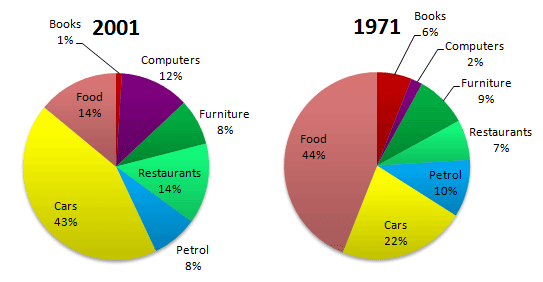Please correct this essay for me. Thank you for your help!
You should spend about 20 minutes on this task.
Topic: The graphs show changes in spending habits of people in UK between 1971 and 2001.
Write a report to a university lecturer describing the data. (Image attached)
Write at least 150 words
The pie charts compare the difference in expenditure allocation in the UK in the years 1971 and 2001 for seven categories.
It is noticeable that the patterns of the amount of money for books and food saw significant increases while the proportion of spending on cars, restaurants and computers increased substantially. On the other hand, there were small differences in the percentages of petrol and furniture consumption.
Food accounted for the highest proportion of UK spending in 1971 with 44%, but it saw a fall into 14% in 2001. Similarly, UK residents spent less money on books in 2001 with 1% comparing to this terms in 1971 with 6%. By contrast, it is clear that budgets for cars, restaurants and computers went up dramatically with 22%, 7% and 2% in 1971 to 43%, 14% and 12% respectively in 2001.
With regards to furniture and petrol, there were just minimal changes in household expenditure. In fact, furniture costs and petrol costs took roughly 9% and 10% of household budgets relatively in 1971 and the UK consumer just allocated 8% in their budgets for both these two types in 2001.
You should spend about 20 minutes on this task.
Topic: The graphs show changes in spending habits of people in UK between 1971 and 2001.
Write a report to a university lecturer describing the data. (Image attached)
Write at least 150 words
difference in expenditure allocation in the UK
The pie charts compare the difference in expenditure allocation in the UK in the years 1971 and 2001 for seven categories.
It is noticeable that the patterns of the amount of money for books and food saw significant increases while the proportion of spending on cars, restaurants and computers increased substantially. On the other hand, there were small differences in the percentages of petrol and furniture consumption.
Food accounted for the highest proportion of UK spending in 1971 with 44%, but it saw a fall into 14% in 2001. Similarly, UK residents spent less money on books in 2001 with 1% comparing to this terms in 1971 with 6%. By contrast, it is clear that budgets for cars, restaurants and computers went up dramatically with 22%, 7% and 2% in 1971 to 43%, 14% and 12% respectively in 2001.
With regards to furniture and petrol, there were just minimal changes in household expenditure. In fact, furniture costs and petrol costs took roughly 9% and 10% of household budgets relatively in 1971 and the UK consumer just allocated 8% in their budgets for both these two types in 2001.

Task <>'" &'ss'>
